Abstract
Neuropeptide-Y (NPY), a brain peptide, is located in the walls of human coronary arteries. This study assessed the effects of NPY on the coronary circulation in 40 chloralose-anesthetized, open-chest dogs. Intracoronary NPY (42 nmol over 5.2 min) caused a 39% reduction in coronary blood flow without changing heart rate or aortic pressure. To determine whether this vasoconstriction could produce ischemia, intramyocardial pH was measured in seven dogs (group I) and decreased from 7.45 +/- 0.06 to 7.37 +/- 0.06 pH units after NPY in the subendocardium (P less than 0.0002), and from 7.45 +/- 0.06 to 7.40 +/- 0.05 pH units (P less than 0.04) in the subepicardium of the infused zone. Left ventricular ejection fraction (LVEF), measured by radionuclide angiography, decreased from 0.52 +/- 0.08 to 0.42 +/- 0.12 U (n = 5, P less than 0.01) during NPY. NPY-induced vasoconstriction was also associated with ST-T wave changes on the electrocardiogram (ECG) in eight of nine other animals (group V). In another group of six dogs (group IV), the change in small vessel resistance accounted for 94% of the increase in total resistance, so that the primary vasoconstrictor effect of NPY was exerted on small coronary arteries. Thus, NPY, a peptide found in human coronary arteries, caused constriction of primarily small coronary arteries that was severe enough to produce myocardial ischemia as determined by ECG ST-T wave changes, and decreases in intramyocardial pH and LVEF in dogs.
Full text
PDF
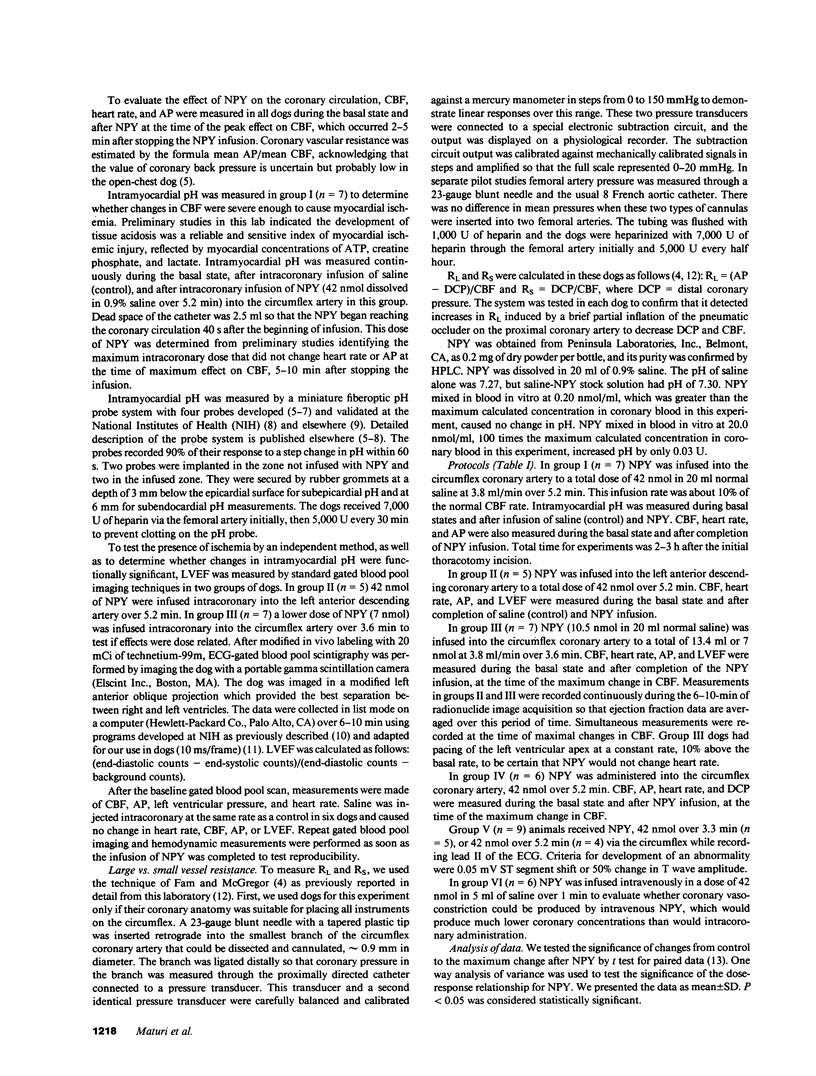

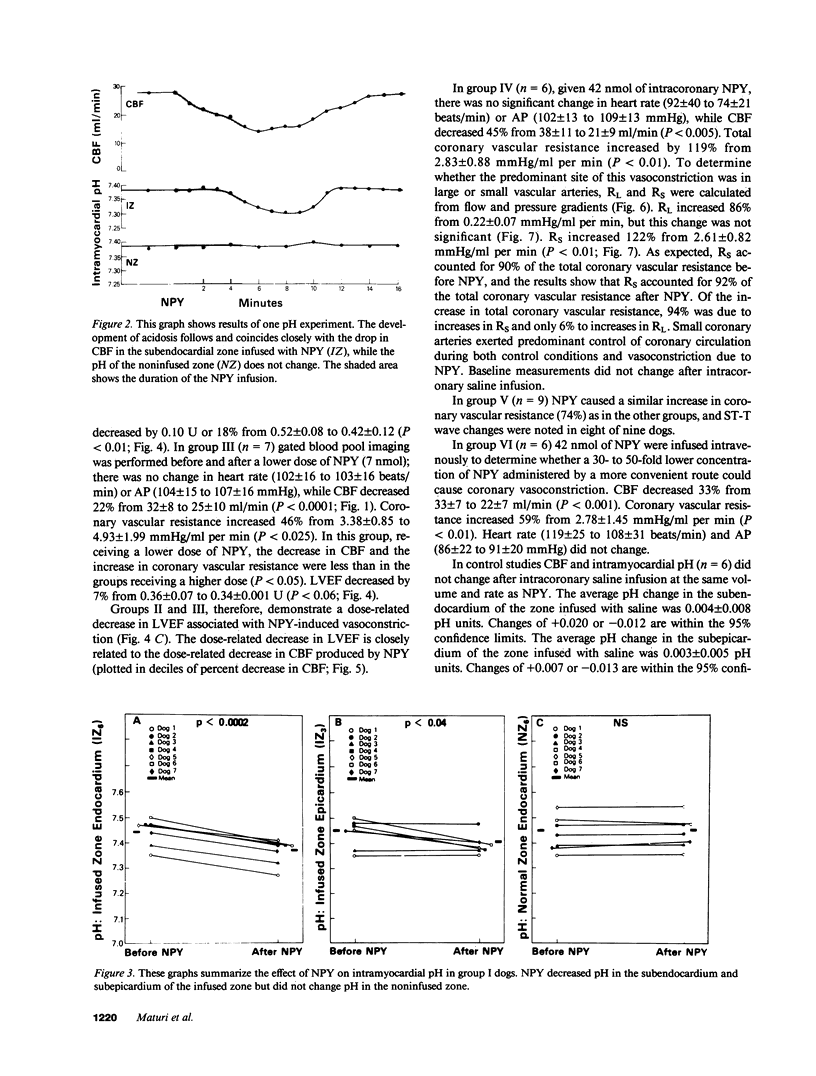
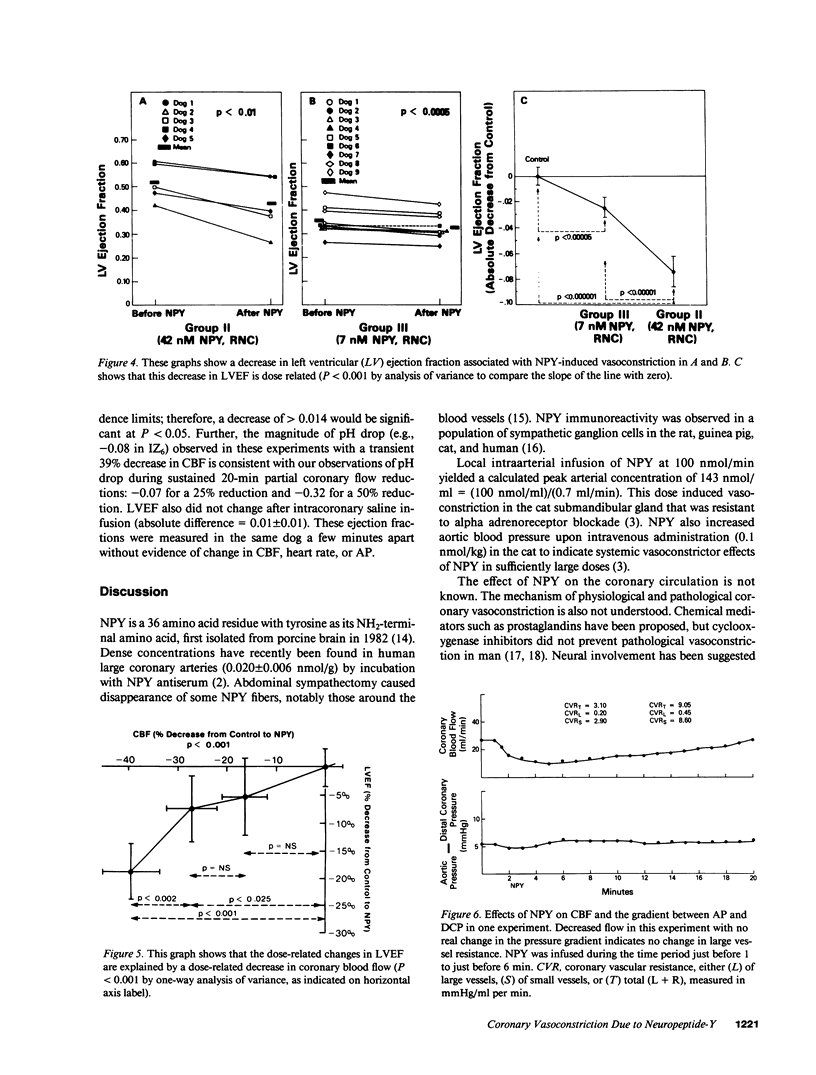
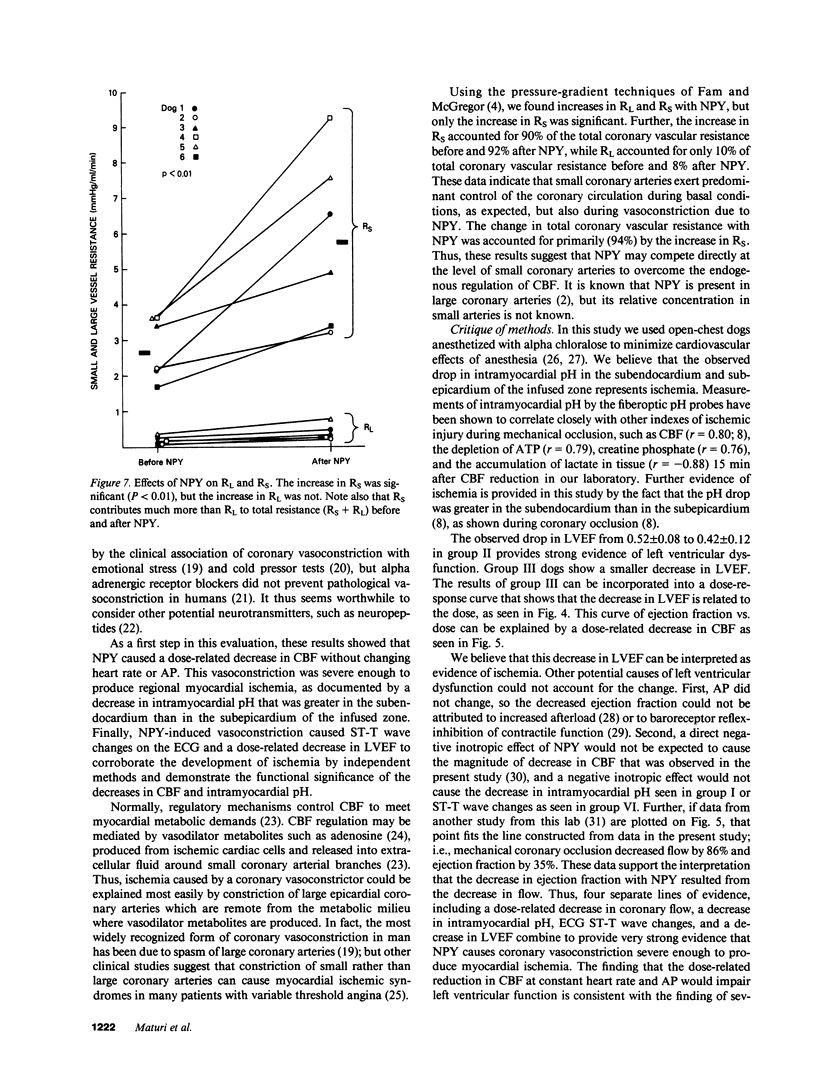
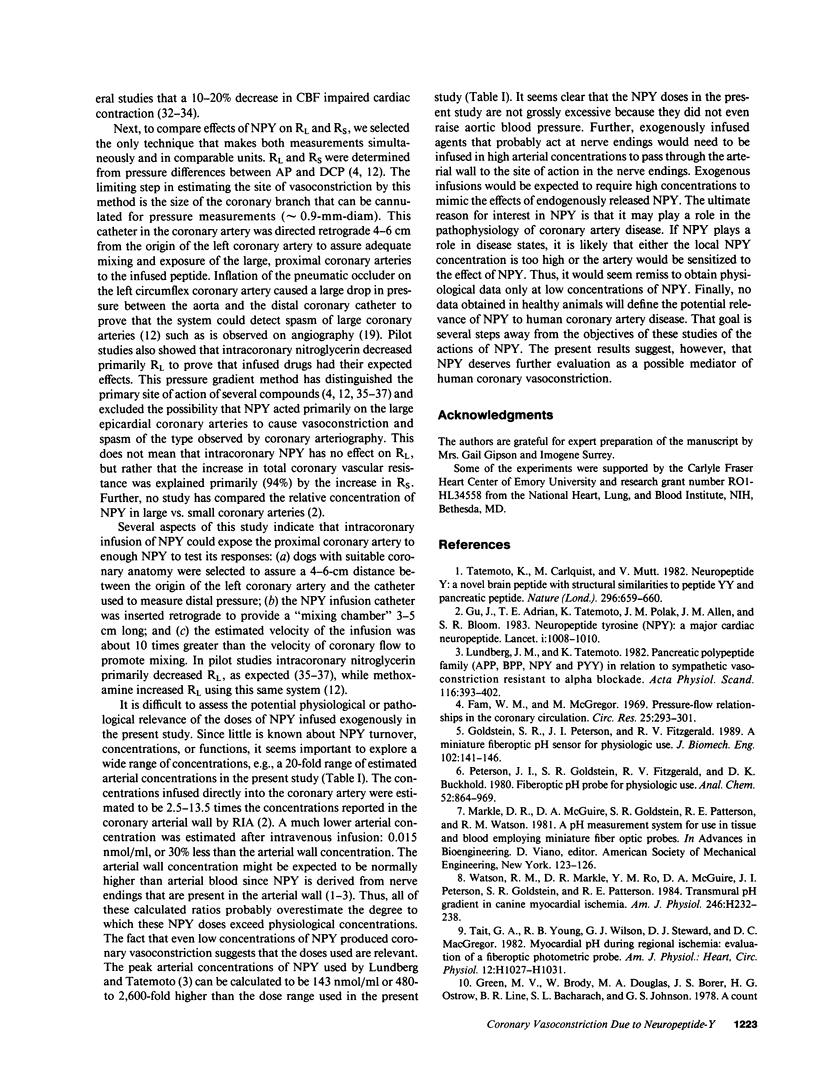
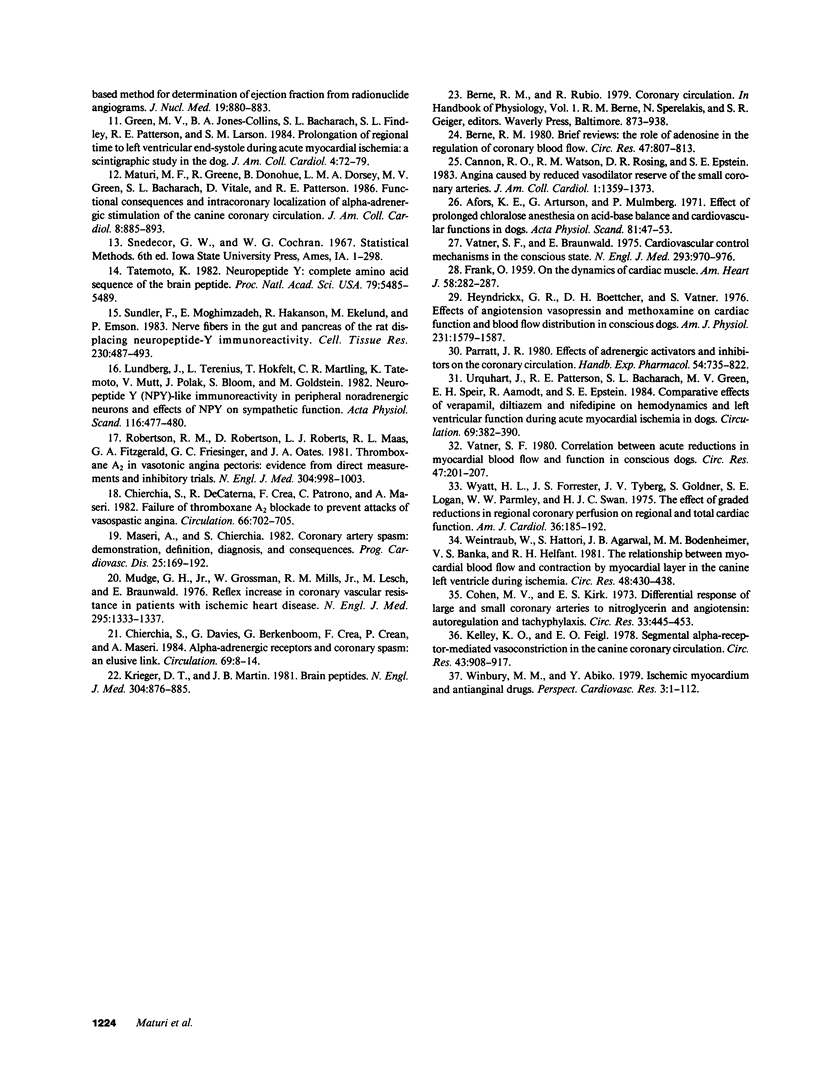
Images in this article
Selected References
These references are in PubMed. This may not be the complete list of references from this article.
- Arfors K. E., Arturson G., Malmberg P. Effect of prolonged chloralose anesthesia on acid-base balance and cardiovascular functions in dogs. Acta Physiol Scand. 1971 Jan;81(1):47–53. doi: 10.1111/j.1748-1716.1971.tb04876.x. [DOI] [PubMed] [Google Scholar]
- Berne R. M. The role of adenosine in the regulation of coronary blood flow. Circ Res. 1980 Dec;47(6):807–813. doi: 10.1161/01.res.47.6.807. [DOI] [PubMed] [Google Scholar]
- Cannon R. O., 3rd, Watson R. M., Rosing D. R., Epstein S. E. Angina caused by reduced vasodilator reserve of the small coronary arteries. J Am Coll Cardiol. 1983 Jun;1(6):1359–1373. doi: 10.1016/s0735-1097(83)80037-0. [DOI] [PubMed] [Google Scholar]
- Chierchia S., Davies G., Berkenboom G., Crea F., Crean P., Maseri A. alpha-Adrenergic receptors and coronary spasm: an elusive link. Circulation. 1984 Jan;69(1):8–14. doi: 10.1161/01.cir.69.1.8. [DOI] [PubMed] [Google Scholar]
- Chierchia S., de Caterina R., Crea F., Patrono C., Maseri A. Failure of thromboxane A2 blockade to prevent attacks of vasospastic angina. Circulation. 1982 Oct;66(4):702–705. doi: 10.1161/01.cir.66.4.702. [DOI] [PubMed] [Google Scholar]
- Cohen M. V., Kirk E. S. Differential response of large and small coronary arteries to nitroglycerin and angiotensin. Autoregulation and tachyphylaxis. Circ Res. 1973 Oct;33(4):445–453. doi: 10.1161/01.res.33.4.445. [DOI] [PubMed] [Google Scholar]
- Fam W. M., McGregor M. Pressure-flow relationships in the coronary circulation. Circ Res. 1969 Sep;25(3):293–301. doi: 10.1161/01.res.25.3.293. [DOI] [PubMed] [Google Scholar]
- Goldstein S. R., Peterson J. I., Fitzgerald R. V. A miniature fiber optic pH sensor for physiological use. J Biomech Eng. 1980 May;102(2):141–146. doi: 10.1115/1.3138210. [DOI] [PubMed] [Google Scholar]
- Green M. V., Brody W. R., Douglas M. A., Borer J. S., Ostrow H. G., Line B. R., Bacharach S. L., Johnston G. S. Ejection fraction by count rate from gated images. J Nucl Med. 1978 Aug;19(8):880–883. [PubMed] [Google Scholar]
- Green M. V., Jones-Collins B. A., Bacharach S. L., Findley S. L., Patterson R. E., Larson S. M. Scintigraphic quantification of asynchronous myocardial motion during the left ventricular isovolumic relaxation period: a study in the dog during acute ischemia. J Am Coll Cardiol. 1984 Jul;4(1):72–79. doi: 10.1016/s0735-1097(84)80321-6. [DOI] [PubMed] [Google Scholar]
- Gu J., Polak J. M., Adrian T. E., Allen J. M., Tatemoto K., Bloom S. R. Neuropeptide tyrosine (NPY)--a major cardiac neuropeptide. Lancet. 1983 May 7;1(8332):1008–1010. doi: 10.1016/s0140-6736(83)92642-9. [DOI] [PubMed] [Google Scholar]
- Heyndrickx G. R., Boettcher D. H., Vatner S. F. Effects of angiotensin, vasopressin, and methoxamine on cardiac function and blood flow distribution in conscious dogs. Am J Physiol. 1976 Nov;231(5 Pt 1):1579–1587. doi: 10.1152/ajplegacy.1976.231.5.1579. [DOI] [PubMed] [Google Scholar]
- Kelley K. O., Feigl E. O. Segmental alpha-receptor-mediated vasoconstriction in the canine coronary circulation. Circ Res. 1978 Dec;43(6):908–917. doi: 10.1161/01.res.43.6.908. [DOI] [PubMed] [Google Scholar]
- Krieger D. T., Martin J. B. Brain peptides (first of two parts). N Engl J Med. 1981 Apr 9;304(15):876–885. doi: 10.1056/NEJM198104093041505. [DOI] [PubMed] [Google Scholar]
- Lundberg J. M., Tatemoto K. Pancreatic polypeptide family (APP, BPP, NPY and PYY) in relation to sympathetic vasoconstriction resistant to alpha-adrenoceptor blockade. Acta Physiol Scand. 1982 Dec;116(4):393–402. doi: 10.1111/j.1748-1716.1982.tb07157.x. [DOI] [PubMed] [Google Scholar]
- Lundberg J. M., Terenius L., Hökfelt T., Martling C. R., Tatemoto K., Mutt V., Polak J., Bloom S., Goldstein M. Neuropeptide Y (NPY)-like immunoreactivity in peripheral noradrenergic neurons and effects of NPY on sympathetic function. Acta Physiol Scand. 1982 Dec;116(4):477–480. doi: 10.1111/j.1748-1716.1982.tb07171.x. [DOI] [PubMed] [Google Scholar]
- Maseri A., Chierchia S. Coronary artery spasm: demonstration, definition, diagnosis, and consequences. Prog Cardiovasc Dis. 1982 Nov-Dec;25(3):169–192. doi: 10.1016/0033-0620(82)90015-9. [DOI] [PubMed] [Google Scholar]
- Maturi M. F., Greene R., Donohue B., Dorsey L. M., Green M. V., Bacharach S. L., Vitale D., Patterson R. E. Functional consequences and intracoronary localization of alpha-adrenergic stimulation of the canine coronary circulation. J Am Coll Cardiol. 1986 Oct;8(4):885–893. doi: 10.1016/s0735-1097(86)80431-4. [DOI] [PubMed] [Google Scholar]
- Mudge G. H., Jr, Grossman W., Mills R. M., Jr, Lesch M., Braunwald E. Reflex increase in coronary vascular resistance in patients with ischemic heart disease. N Engl J Med. 1976 Dec 9;295(24):1333–1337. doi: 10.1056/NEJM197612092952401. [DOI] [PMC free article] [PubMed] [Google Scholar]
- Peterson J. I., Goldstein S. R., Fitzgerald R. V., Buckhold D. K. Fiber optic pH probe for physiological use. Anal Chem. 1980 May;52(6):864–869. doi: 10.1021/ac50056a022. [DOI] [PubMed] [Google Scholar]
- Robertson R. M., Robertson D., Roberts L. J., Maas R. L., FitzGerald G. A., Friesinger G. C., Oates J. A. Thromboxane A2 in vasotonic angina pectoris: evidence from direct measurements and inhibitor trials. N Engl J Med. 1981 Apr 23;304(17):998–1003. doi: 10.1056/NEJM198104233041703. [DOI] [PubMed] [Google Scholar]
- Sundler F., Moghimzadeh E., Håkanson R., Ekelund M., Emson P. Nerve fibers in the gut and pancreas of the rat displaying neuropeptide-Y immunoreactivity. Intrinsic and extrinsic origin. Cell Tissue Res. 1983;230(3):487–493. doi: 10.1007/BF00216194. [DOI] [PubMed] [Google Scholar]
- Tait G. A., Young R. B., Wilson G. J., Steward D. J., MacGregor D. C. Myocardial pH during regional ischemia: evaluation of a fiber-optic photometric probe. Am J Physiol. 1982 Dec;243(6):H1027–H1031. doi: 10.1152/ajpheart.1982.243.6.H1027. [DOI] [PubMed] [Google Scholar]
- Tatemoto K., Carlquist M., Mutt V. Neuropeptide Y--a novel brain peptide with structural similarities to peptide YY and pancreatic polypeptide. Nature. 1982 Apr 15;296(5858):659–660. doi: 10.1038/296659a0. [DOI] [PubMed] [Google Scholar]
- Tatemoto K. Neuropeptide Y: complete amino acid sequence of the brain peptide. Proc Natl Acad Sci U S A. 1982 Sep;79(18):5485–5489. doi: 10.1073/pnas.79.18.5485. [DOI] [PMC free article] [PubMed] [Google Scholar]
- Urquhart J., Patterson R. E., Bacharach S. L., Green M. V., Speir E. H., Aamodt R., Epstein S. E. Comparative effects of verapamil, diltiazem, and nifedipine on hemodynamics and left ventricular function during acute myocardial ischemia in dogs. Circulation. 1984 Feb;69(2):382–390. doi: 10.1161/01.cir.69.2.382. [DOI] [PubMed] [Google Scholar]
- Vatner S. F., Braunwald E. Cardiovascular control mechanisms in the conscious state. N Engl J Med. 1975 Nov 6;293(19):970–976. doi: 10.1056/NEJM197511062931906. [DOI] [PubMed] [Google Scholar]
- Vatner S. F. Correlation between acute reductions in myocardial blood flow and function in conscious dogs. Circ Res. 1980 Aug;47(2):201–207. doi: 10.1161/01.res.47.2.201. [DOI] [PubMed] [Google Scholar]
- Watson R. M., Markle D. R., Ro Y. M., Goldstein S. R., McGuire D. A., Peterson J. I., Patterson R. E. Transmural pH gradient in canine myocardial ischemia. Am J Physiol. 1984 Feb;246(2 Pt 2):H232–H238. doi: 10.1152/ajpheart.1984.246.2.H232. [DOI] [PubMed] [Google Scholar]
- Weintraub W. S., Hattori S., Agarwal J. B., Bodenheimer M. M., Banka V. S., Helfant R. H. The relationship between myocardial blood flow and contraction by myocardial layer in the canine left ventricle during ischemia. Circ Res. 1981 Mar;48(3):430–438. doi: 10.1161/01.res.48.3.430. [DOI] [PubMed] [Google Scholar]
- Wyatt H. L., Forrester J. S., Tyberg J. V., Goldner S., Logan S. E., Parmley W. W., Swan H. J. Effect of graded reductions in regional coronary perfusion on regional and total cardiac function. Am J Cardiol. 1975 Aug;36(2):185–192. doi: 10.1016/0002-9149(75)90524-x. [DOI] [PubMed] [Google Scholar]



